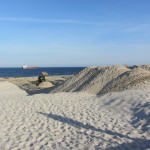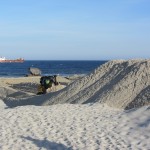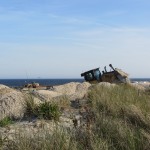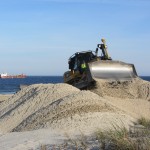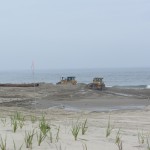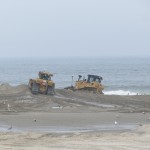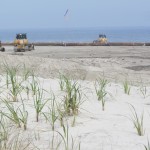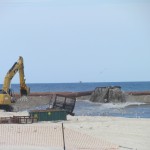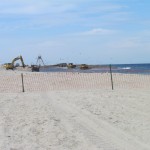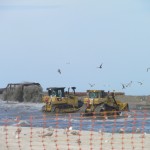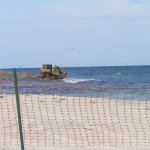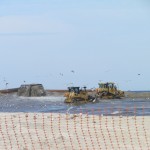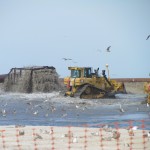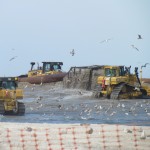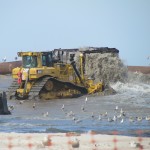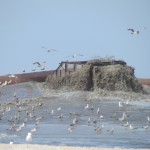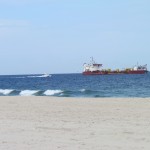 Beaches are always changing with sand being washed away and added to them and can change depending on the strength and frequency of storms. The Long Beach Island beach replenishment project will help reduce erosion and property damages associated with coastal storms, The US Army Corps of Engineers designed the Barnegat Inlet to Little Egg Harbor Inlet Long Beach Island Storm Reduction Project
Beaches are always changing with sand being washed away and added to them and can change depending on the strength and frequency of storms. The Long Beach Island beach replenishment project will help reduce erosion and property damages associated with coastal storms, The US Army Corps of Engineers designed the Barnegat Inlet to Little Egg Harbor Inlet Long Beach Island Storm Reduction Project
The beach replenishment project started in November 2009 in Harvey Cedars. The work involves dredging millions of cubic yards of sand from an approved borrow area approximately three miles offshore and pumped through a series of pipes onto the beaches. The sand is then built into a dune and berm system designed to reduce potential damages to infrastructure, businesses, and homes that can occur from coastal storm events.
Long Beach Township modified an old ordinance that would require oceanfront owners to pay for sand and dune maintenance in front of their homes if they did not sign the easement to allow The U.S. Army Corps of Engineers Beach Replenishment project to proceed. The ordinance states that if homeowners refuse to do the work within 15 days, the township will do it and then bill them. The charge for the township to do the work will become a lien against the property.
The beaches can erode badly during the winter due to the strength and frequency of coastal storms and beaches not part of the beach replenishment project are more vulnerable. During the winter months, storms can cause a beach to erode and result in a seaward-sloping beach. The beach gradually accumulates sand as the result of currents produced by low waves that return sand to the beach during the calmer summer months.
A severe storm with high tides and strong wind and waves may cause significant erosion in a very short amount of time and could take months of normal wave and tidal conditions for the beach to recover. If storms that roll in one after the other, the beaches take a longer time to replenish themselves.
Healthy beaches are our first line of defense to protect homes, businesses and inland structures along the coast by acting as a barrier from the pounding repetitive wave action resulting from coastal storms.
Natural removal and transport of sand will continue and the beach replenishment project cannot prevent erosion but a nourished beach provides storm protection. A wide beach is able to absorb energy from the wave impact of storms and replenished beaches will have to be maintained and nourished. Beach nourishment is not a one-time event but an ongoing maintenance project. Beach replenishment and nourishment is the best solution right now to allow continued normal use of our beaches.
DUNE GRASS
The best time to plant dune grass is from mid-October through March (the dune grass dormancy period). On the other hand, if the winter storm season is severe, high tides and waves may erode dunes and newly planted dune grass before the root system develops.
Once established, dune grass spreads by underground stems to form a dense vegetative cover. The foliage decreases the wind velocity near the dune surface, and sand is deposited in the vegetation. As the sand continues to accumulate, the grass grows up through it, maintaining a protective cover.
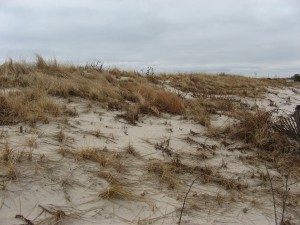
In the winter, dune grass looks as if it died off but the roots are still alive. Even though the grass leaves and stems are brown, they are still effective in trapping wind-blown sand. Depending on springtime temperatures this year, you’ll probably be able to observe new green shoots growing up at the base of each brown clump of grass by the middle of April.
Dune grass can tolerate the harsh conditions on the coast but cannot withstand foot traffic. These activities crush plant shoots and roots. Trampling by pedestrians and often lead to greater sand removal by wind. As summer approaches and the crowds step onto the beaches, many people are unaware of how fragile the dune grass system is and how important it is in maintaining our beaches for future use. Protect Long Beach Island beaches and share the word about our dunes and dune grass.
Summer Beach Replenishment
Sometimes the beach replenishment project comes at the most inconvenient times like in the middle of summer! We understand how inconvenient a 24/7 construction job can be during the peak vacation season, but work is completed as fast as possible considering all factors such as federal funding timing. The timing of the real estate rights to legally construct a project before awarding a construction contract.
A large project means a large contract which has to provide private industry with an ample amount of time, often in excess of 300 days, to complete the work. If not enough time is provided, there is a risk of receiving bids that are too high to be considered, or receiving no bids at all.
It’s also important to note there is a limited number of dredges that can handle beach fill operations. The safest and most efficient use of these dredges is often during the summer because of calmer seas. In addition, these same dredges already do most of the large navigation projects within U.S. waters, and when there is a large amount of emergency beach fill or channel dredging, the demand inevitably exceeds the supply. So if summer work is excluded, then that increases the risk of pricing the project out of the bidding market and not being able to build these projects at all.
Lastly, the mission in these projects is to protect communities by reducing the risk of storm damages, whether from a September hurricane or a March nor’easter. Once a project is ready to build, there is a clear responsibility to do so – as opposed to leaving any community exposed any longer than necessary. Ideally summer beach nourishment would like to be avoided with the full awareness of the economic importance of this season. To help soften the impact, during construction no more than 1,000 feet of beach at a time is closed; this allows continued access for beach goers by detouring no more than a block or two from any given point.
Dune Structure
In the past, there has been question about slope modification at various locations because of concern over the potential for increased risks to swimmers with the current slope formula utilized throughout most of the project area. Many residents have also requested a gentler slope but there were practical mechanical restrictions and budget limits to prevent it. The standard slope design is intended to allow erosion for the beach to return to its more natural profile. This process should take only one winter season.
Although some people have complained about the variability in sand laid during the different sections of the project, the grain size and quality of the sand obtained from offshore borrow zones are pretty consistent throughout the entire project. However, there may be slight differences based upon the location of the cuts in the borrow area.
Beach Replenishment photos
Reference: NOAA Coastal Services Center
Click HERE to visit the US Army Corps of Engineers website for more information
Lt. Col. Michael Bliss is commander of the U.S. Army Corps of Engineers, Philadelphia District.



